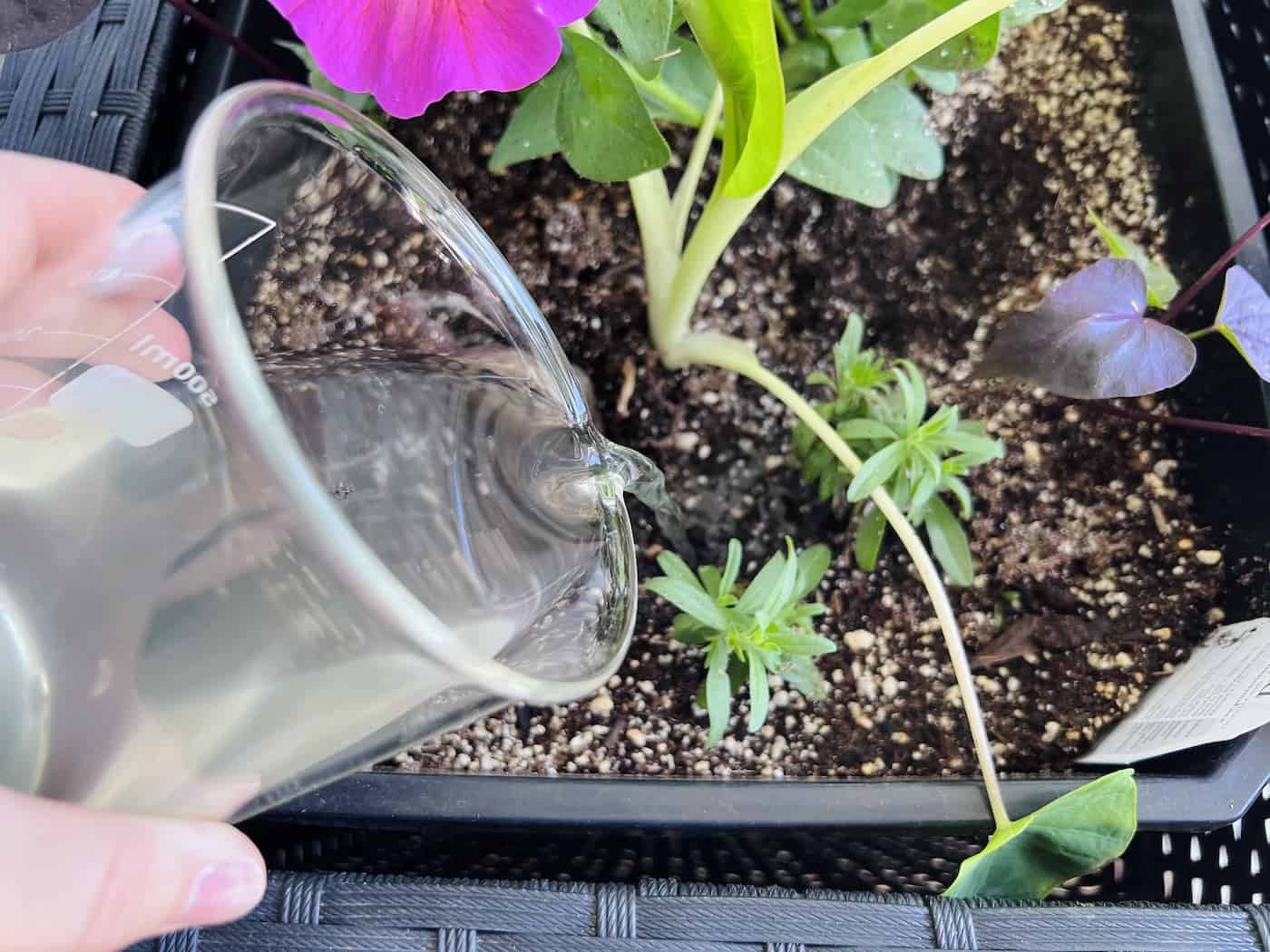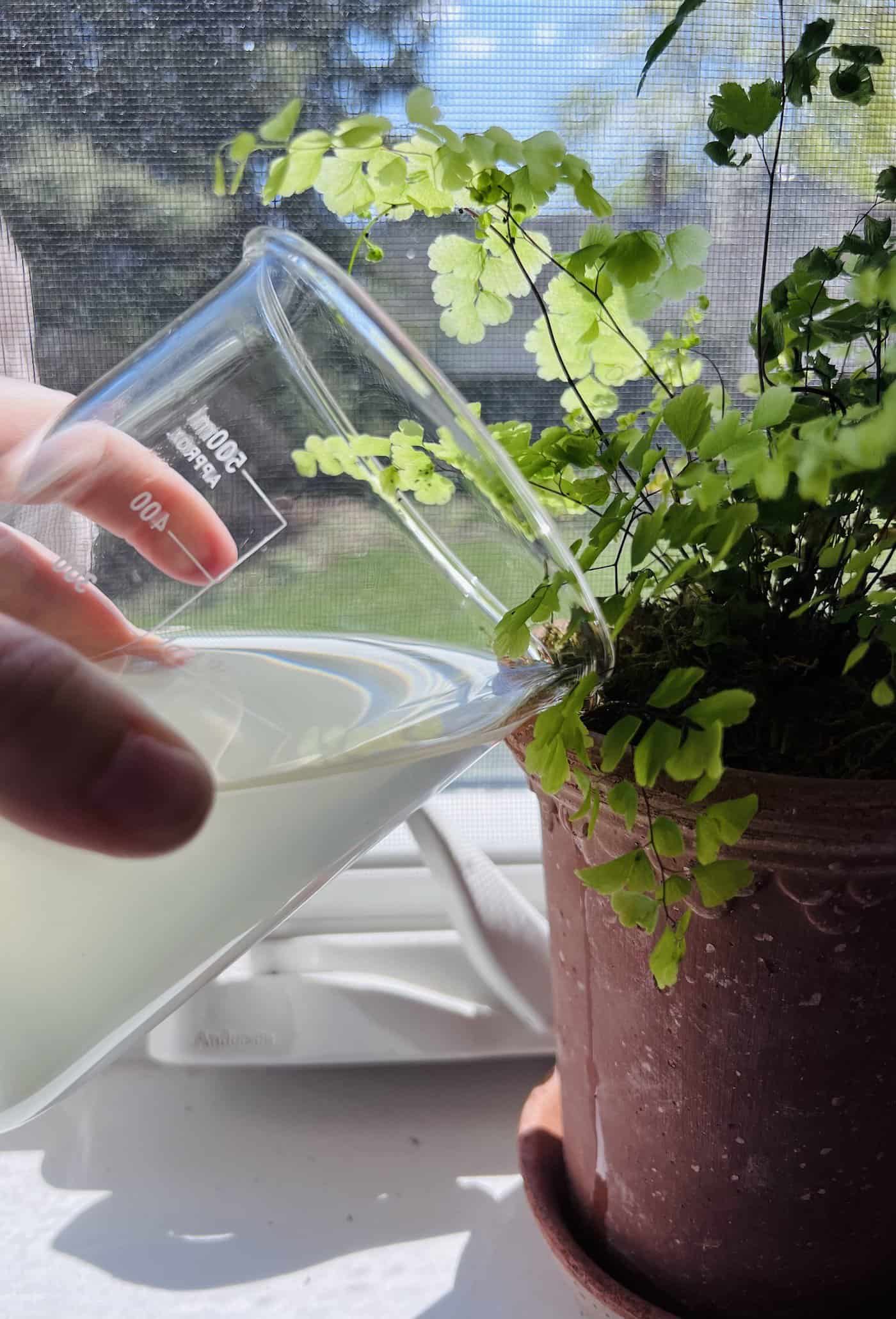Wondering about using phytoplankton fertilizer in your garden? This product is popping up at garden centers everywhere!
Phytoplankton fertilizer is a soil-enhancing product used in organic gardening to add nutrients. This liquid fertilizer contains millions of cells of microalgae that contain key minerals like nitrogen, magnesium, calcium, and potassium. Phytoplankton fertilizer is an eco-friendly, pet-safe, and scent-free alternative to other more common plant food products. It will be interesting to see the results of any formal studies of this plant food product.
Let’s learn more about feeding plants with phytoplankton and algae as fertilizer.
Phytoplankton fertilizer
Phytoplankton fertilization is an inventive and green approach to enhance your plants’ development while positively affecting nature. These microscopic organisms are primary producers in marine ecosystems, storing excess carbon dioxide and providing a crucial food source for countless species.
While using excess conventional fertilizers can cause unwanted algae blooms in waterways, using phytoplankton as fertilizer is an emerging trend that may be more eco-friendly. By properly using phytoplankton fertilizer in your garden or agricultural setting, you can contribute positively towards maintaining a balanced ecosystem while enjoying bountiful harvests from your crops.
Phytoplankton fertilizer can be used for indoor plants, hydroponics, container gardens, in-ground vegetable gardens, flower beds, and turf grass. One of the most popular phytoplankton fertilizer brands is Marphyl.

What is phytoplankton?
Phytoplankton are microscopic, single-celled organisms that inhabit both fresh and saltwater habitats, serving as a source of nourishment for various aquatic creatures such as fish, shellfish, and even whales. Phytoplankton is sometimes referred to as microalgae.
Phytoplankton forms the base of the aquatic food chain, providing sustenance for a wide variety of marine life, such as fish, shellfish, and even whales. These microscopic plants use photosynthesis to convert sunlight into energy while simultaneously absorbing carbon dioxide (CO2) from their surroundings.
The benefits of phytoplankton fertilizer
Here are some of the most popular reasons gardeners choose phytoplankton as fertilizer:
- Natural source: As opposed to synthetic fertilizers derived from petrochemicals and mined minerals, which may contain harmful chemicals or pollutants, phytoplankton fertilizer offers a potentially safer alternative made entirely from organic materials.
- Eco-friendly: The production process involved in harvesting phytoplankton has minimal environmental impact compared to other methods used in creating conventional fertilizers.
- Rapid nutrient absorption: Due to its small particle size (nanometer scale) and high bioavailability levels (easily absorbed by plants), phytoplankton fertilizer possibly provides a quick and efficient nutrient delivery system for your garden.
- Enhanced plant growth: The wide range of plant nutrients found in phytoplankton, including essential minerals that can help promote healthy root development and overall plant vigor.
The nutrient composition of phytoplankton fertilizer
Phytoplankton fertilizer is packed with essential nutrients that are beneficial for plant growth and health. Some key components include:
- Nitrogen (N): An essential element for proper plant growth, nitrogen promotes strong stem development and lush foliage.
- Phosphorus (P): Phosphorus aids in root formation as well as flower production. It also plays a crucial role in energy transfer within plants.
- Potassium (K): Potassium helps regulate water balance within cells while also supporting photosynthesis processes by activating enzymes needed for carbohydrate metabolism.
In addition to these primary macronutrients, phytoplankton fertilizers also contain micronutrients such as calcium, magnesium, sulfur along with trace elements like iron, manganese, and zinc which all contribute towards maintaining optimal soil fertility levels thereby ensuring robust plant growth over time.
The guaranteed analysis of a fertilizer product should be listed on its packaging. Note that the percentages of N,P,K and other minerals will likely be much lower than for conventional and even other organic options. A conventional fertilizer might have an NPK ratio of 10-10-10, while an organic product might have a ratio of 1-1-1, and a phytoplankton fertilizer might have an NPK ratio of 0.19-0.001-0.03. The concentration of minerals is generally substantially lower in phytoplankton fertilizers than in most other packaged plant food products.

Finding phytoplankton garden products
To ensure you’re using the best product for your garden’s needs, it’s important to research different options available today. Look out for reputable brands offering high-quality products made from sustainably harvested marine sources.
Powdered vs. liquid phytoplankton fertilizer
The initial selection is whether powdered or liquid phytoplankton fertilizer will be employed. Powdered fertilizers are typically more concentrated and require mixing with water before application, while liquid fertilizers come pre-mixed and ready to use.
- Powdered: Powdered phytoplankton fertilizer may be right for you if you’re looking for an economical option that allows greater control over concentration levels. It has a longer shelf life than its liquid counterpart but requires extra effort in preparation.
- Liquid: For those who prefer convenience and ease of use, consider using a liquid phytoplankton fertilizer. Although often less cost-effective due to lower concentrations per bottle than powder form, it saves time by eliminating the need for mixing before application.
Freshwater vs. marine-based phytoplankton fertilizer
Different sources of phytoplankton can impact their nutrient content as well as their suitability for specific plant types or growing conditions.
- Freshwater: Freshwater-based fertilizers contain species like Spirulina which thrive in non-saline environments such as lakes or ponds (source). These products are typically rich in nitrogen, making them ideal for leafy greens and other plants that require high levels of this nutrient.
- Marine: Marine-based phytoplankton fertilizers derive from ocean-dwelling species like Nannochloropsis or Tetraselmis. They offer a more balanced nutrient profile with higher concentrations of trace elements (source). This makes them suitable for a broader range of plant types and growing conditions.
Certified organic vs. non-organic phytoplankton fertilizer
For those devoted to keeping a natural garden, make sure the phytoplankton fertilizer you select is officially recognized organic by a certifying organization such as OMRI (Organic Materials Review Institute) or USDA (United States Department of Agriculture). While non-organic options may be less expensive, they might not align with your gardening principles or meet specific requirements if you plan on selling your produce as “organic.”
Tips for choosing phytoplankton fertilizer:
- Determine your garden’s primary needs: Are you looking to boost nitrogen levels for leafy greens? Or do you need a well-rounded option suitable for various plant types?
- Consider ease-of-use: Do you prefer the convenience of liquid fertilizers, or are you willing to mix powdered products yourself?
- Evaluate cost-effectiveness: Powdered options often provide more bang-for-your-buck but come at the expense of added preparation time.
- Stay true to your values: If organic gardening is important to you, make sure the product meets certification standards.
Choosing the right fertilizer is essential to ensure your garden grows healthy and strong. Once you’ve decided on the right fertilizer, it’s time to get your garden ready for application.
Preparing your garden for fertilizing
Before fertilizing with phytoplankton, ensure the soil and plants are prepped correctly to maximize the absorption of nutrients. Plan ahead for a healthier and more dynamic garden to guarantee that your plants can make the most of the supplements in the manure. Follow these simple steps to ensure your garden is prepared for fertilizing with phytoplankton.
Testing your soil
The first step in preparing your garden is testing your soil’s pH level and nutrient content. Knowing this information will help you determine if any adjustments are needed before applying phytoplankton fertilizer. You can purchase an affordable soil test kit at most gardening stores or online retailers.
If your soil test indicates an imbalance in pH levels, amendments such as lime for acidic soils or sulfur/aluminum sulfate for alkaline soils can help to adjust the balance before adding fertilizers. You may also want to consider incorporating organic matter like compost into the soil; this helps improve overall fertility but also aids in balancing out extreme pH levels over time.
Clearing weeds and debris
Weeds compete with desirable plants for water, sunlight, and nutrients, so ensure they’re removed from around plantings before applying fertilizer. Additionally, clear away any debris, such as fallen leaves or branches, which could impede the absorption of nutrients by plant roots.
Watering your garden
Before applying phytoplankton fertilizer, it’s important to ensure your garden is well-watered. This will help the nutrients in the fertilizer dissolve and become more readily available for plant uptake. Water your plants a day or two before fertilizing, ensuring that the soil is evenly moistened – but not overly saturated, as this can cause root rot and other problems.
Choosing appropriate timing
The best time to apply phytoplankton fertilizer varies depending on climate, plant type, and growth stage; however, spring is generally ideal for most gardens. If you’re unsure about when exactly would be best for your specific situation – don’t hesitate to consult with local gardening experts or cooperative extension services.
By following these steps carefully and ensuring that your garden is properly prepared beforehand, you’ll set yourself up for success when applying phytoplankton-based fertilizers. With just a little bit of effort upfront – you’ll soon be reaping all of the incredible benefits of using this eco-friendly alternative in your home garden.
By utilizing the measures specified in this article, you can successfully get your garden ready for fertilizing. Next, we will apply phytoplankton fertilizer to give your plants the required nutrients.

Applying phytoplankton fertilizer
If you’re ready to boost your garden with phytoplankton fertilizer, knowing the proper techniques for applying it is essential. In this section, we’ll provide you with the necessary steps to ensure your plants get the best out of this natural fertilizer.
Determine application rate and frequency
First, determine how much phytoplankton fertilizer you need and how often to apply it. Refer to the manufacturer’s instructions on your specific product for optimal results.
As for frequency, many gardeners successfully apply phytoplankton fertilizer every two weeks during the growing season or monthly as a maintenance treatment outside of peak growth periods. Again, refer to the manufacturer’s instructions.
Mix your solution
Mix one-part phytoplankton concentrate with water in a large container or bucket to create your diluted solution. Make sure you stir well to evenly distribute everything before moving on to the application.
Choose an application method
You have several options when it comes time actually to apply your mixed solution:
- Soil drench: Pour your solution directly onto the soil around the base of each plant, allowing it to soak in and reach the roots, where nutrients are absorbed most efficiently. Be sure not to oversaturate or flood your plants. Aim for a slow, steady pour that moistens without overwhelming.
- Irrigation system: If you have an existing drip irrigation or soaker hose setup in your garden, you can add phytoplankton fertilizer directly into these systems for easy distribution throughout your growing space.
- Foliar spray: Using a spray bottle or pump sprayer filled with your prepared mixture, lightly mist plant leaves until damp but not dripping wet. This allows nutrients from the phytoplankton to be absorbed directly through the foliage.
Apply at optimal time of the day
To maximize absorption and minimize waste, try applying phytoplankton fertilizer when plants actively take up water and nutrients. Early morning or late afternoon hours tend to be best as temperatures are cooler and evaporation rates lower than during peak daytime heat.
Monitor results & adjust as needed
Monitor your plants’ progress after applying phytoplankton fertilizer, assessing whether they demonstrate improved growth with greener and more vibrant leaves. Are they showing signs of improved growth? Do their leaves appear greener and more vibrant? If not, consider adjusting application rates or frequency based on what you observe. Every garden is unique.
Incorporating phytoplankton fertilizer into your gardening routine doesn’t have to be complicated. By following these simple steps for proper application techniques, you’ll soon see why this natural wonder has become such a popular choice among eco-conscious gardeners everywhere.
Utilizing phytoplankton fertilizer can be a great way to maintain the vitality of your garden. By maintaining a regular fertilizing schedule, you can reap the rewards of using this unique form of plant nutrition for years to come. Next, we’ll delve into the ways to keep a garden in optimal condition by utilizing phytoplankton fertilizer.
Maintaining a healthy garden with phytoplankton fertilizer
To ensure a thriving garden, phytoplankton fertilizer can provide the necessary nutrients while also preserving sustainability. Phytoplankton fertilizer can provide your garden with the necessary nutrients to stay healthy while promoting sustainability. In this part, we’ll investigate some strategies and tips for keeping a flourishing garden with the utilization of phytoplankton fertilizer.
Avoid over-fertilizing
Many gardeners make the misstep of applying too much fertilizer to their plants. Excessive amounts of any kind of fertilizer can be detrimental, so adhering to the manufacturer’s suggested application rates is important. To avoid over-fertilization, follow the manufacturer’s recommended application rates and closely monitor your plants’ health.
Monitor soil pH levels
The optimal soil pH level varies depending on the type of plant you’re growing; however, most prefer slightly acidic conditions (around 6-7). Using an at-home soil test kit or sending samples to a professional lab will help ensure your soil remains within optimal ranges for nutrient absorption.
Water wisely
- Irrigation: Proper watering techniques are crucial when using any type of fertilizer in your garden. Be sure to water deeply but infrequently so that roots have time to absorb both moisture and nutrients from the soil before evaporating.
- Rainwater harvesting: Collecting rainwater in barrels or other containers allows you to conserve resources while providing chemical-free hydration for your plants – perfect for use alongside natural fertilizers like phytoplankton.
Before you go…
Understanding how to use phytoplankton fertilizer can help homeowners maintain a healthy garden without needing extensive gardening knowledge. Selecting suitable fertilizer and administering it suitably can guarantee that your plants get the essential nutrients they need for flourishing growth.
Using plankton fertilizers benefits your garden and supports sustainable practices by utilizing natural resources. Encouraging phytoplankton growth can lead to phytoplankton abundance, which can store excess carbon dioxide and safely sequester carbon in oceans responsibly. This proposed fertilization can also effectively fertilize the plankton community, allowing plankton to grow and become primary producers in ocean ecosystems. Iron-rich engineered fertilizer particles can safely enhance plankton growth and nutrient uptake in specific ocean environments.






